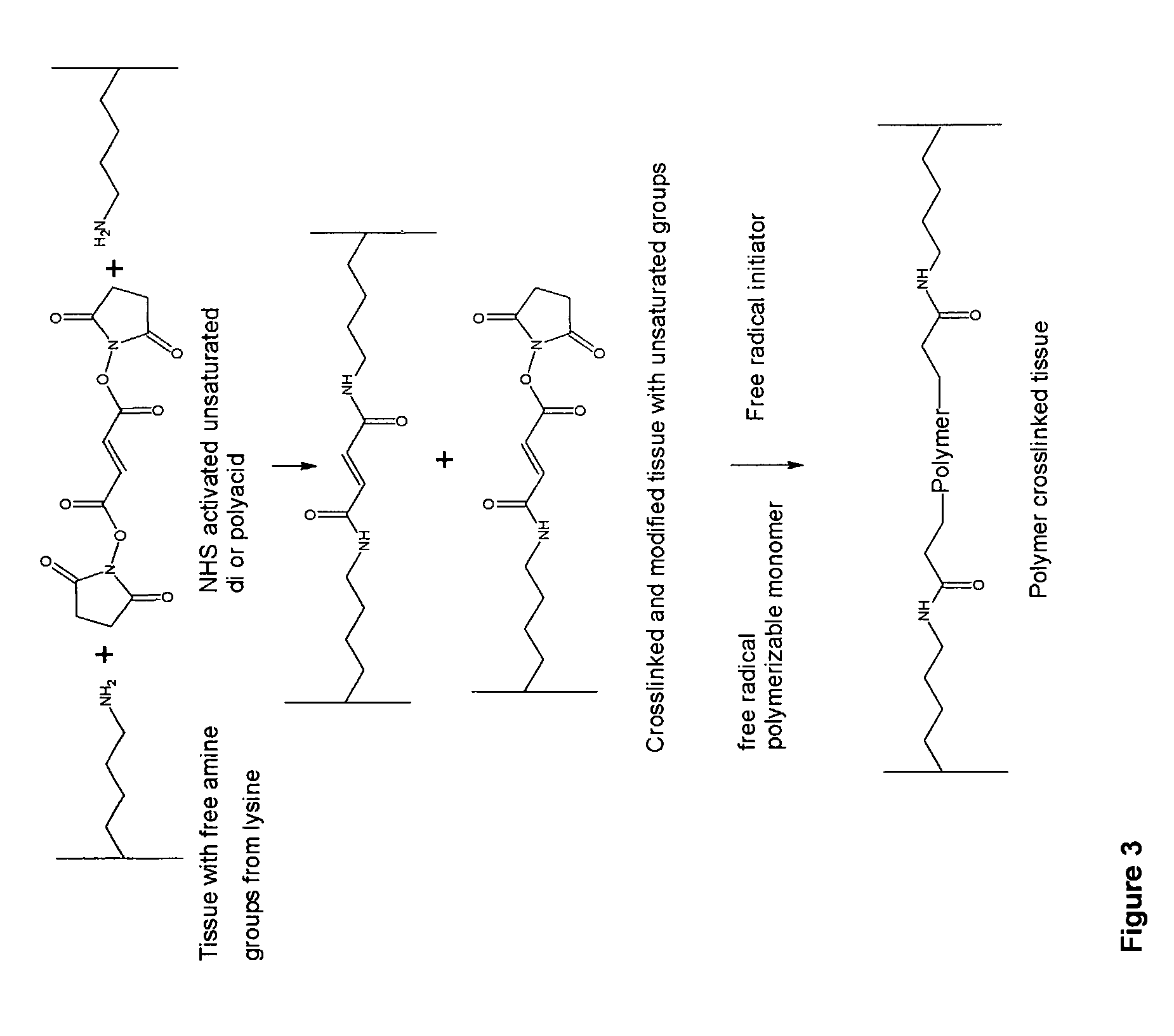Implantable tissue compositions and method
a tissue composition and composition technology, applied in the field of implantable tissue compositions and methods, can solve the problems of unwanted degradation, control over the degradation process, and inability to release bioactive compounds in a controlled manner
- Summary
- Abstract
- Description
- Claims
- Application Information
AI Technical Summary
Benefits of technology
Problems solved by technology
Method used
Image
Examples
example 1
Modification of Tissue Using Unsaturated Succinimide Ester (Acrylic Acid Succinimide Ester)
[0290]Modification of Bovine Pericardium Tissue.
[0291]Ten 1 cm by 1 cm bovine pericardium pieces, cut from a freshly obtained bovine pericardial sac, are transferred to 50 ml conical flask containing 10 ml phosphate buffered saline (PBS, pH 7.2). 250 mg acrylic acid succinimide ester (ANHS) (Sigma-Aldrich Product Number: A8060) dissolved in 0.5 ml dimethyl sulfoxide is added to the conical flask and the solution is vortexed for 15 minutes. 0.1 g of ANHS in 0.1 ml DMSO is added to the fixation solution every 2 hours up to six hours. The modification reaction is carried for 6 hours at ambient temperature (25° C.) and then for 12 hours at 4° C. with gentle shaking. The reaction is terminated by washing the tissue with 20 ml PBS 3 times. Finally, the tissue is stored in 30 ml 38% isopropanol and 2% benzyl alcohol solution at 4° C. until further use.
[0292]In another variation of this method, porcin...
example 2
Modification of Tissue Using Glycidyl Methacrylate
[0299]10 pieces of 1 cm by 1 cm bovine pericardium tissue are transferred to 100 ml conical flask containing ten ml PBS and a magnetic stir bar. To this solution, 2 ml glycidyl methacrylate, 2 ml triethyl amine and 0.5 g tetrabutylamine hydrobromide are added. The reaction is carried for 16 hours at ambient temperature (25° C.) and then 50° C. for 4 hours with gentle stirring. The solution is cooled and the tissue is isolated from the reaction mixture. The isolated tissue is washed with PBS and 40% ethanol to remove traces of glycidyl methacrylate and other catalysts.
example 3
Modification Tissue Using Acrolein
[0300]Ten 1 cm by 1 cm bovine pericardium pieces are transferred to 50 ml conical flask containing 10 ml PBS and 0.60 ml acrolein. The tissue is incubated for 6 hours at ambient temperature (25° C.). An additional 0.1 g acrolein is added to the mixture at every 1.5 hours up to six hours. Finally, the reaction is continued for 4° C. for 48-120 hours with gentle stirring. The tissue is isolated from the reaction mixture and is washed with PBS and 40% ethanol to remove unreacted acrolein.
PUM
 Login to View More
Login to View More Abstract
Description
Claims
Application Information
 Login to View More
Login to View More - R&D
- Intellectual Property
- Life Sciences
- Materials
- Tech Scout
- Unparalleled Data Quality
- Higher Quality Content
- 60% Fewer Hallucinations
Browse by: Latest US Patents, China's latest patents, Technical Efficacy Thesaurus, Application Domain, Technology Topic, Popular Technical Reports.
© 2025 PatSnap. All rights reserved.Legal|Privacy policy|Modern Slavery Act Transparency Statement|Sitemap|About US| Contact US: help@patsnap.com



